The Dangers of Fire Restoration Cleaning
The Dangers of Fire Restoration Cleaning
Summary
The article outlines the complexities and dangers of fire restoration cleaning, emphasising the importance of professional services to manage health risks from soot, smoke, structural damage, and toxic chemicals. It highlights the need for timely, expert restoration to mitigate further damage and ensure safety.
Fire restoration cleaning is an essential but often underestimated process in the aftermath of a fire incident. As a complex and intricate task, it requires not only thoroughness but also an understanding of the potential hazards involved. In this comprehensive guide, we delve into the dangers associated with fire restoration cleaning and provide expert advice on how to navigate these challenges safely.
Understanding the Risks of Fire Damage
Fire damage extends beyond the immediately visible char and soot. The aftermath of a fire leaves behind a host of hazardous materials and conditions, including structural weaknesses, toxic chemicals, and harmful particulates. These risks necessitate a careful and informed approach to restoration.
Structural Instability and Safety Concerns
One of the primary dangers in fire restoration is dealing with structural damage. Fire can compromise the integrity of building materials, making them unsafe for untrained individuals to navigate. Professional restoration teams are equipped with the necessary skills and equipment to assess and address these dangers.
Health Hazards from Soot and Smoke Residues
Soot and smoke residues present significant health risks. These residues often contain a mix of harmful chemicals and particulates, including carcinogens. Prolonged exposure without proper protective gear can lead to respiratory issues, skin irritation, and other health complications.
The Hidden Menace of Water Damage and Mould
Often overlooked, water damage from firefighting efforts can lead to mould growth. Mould poses its own set of health risks, particularly for individuals with allergies or compromised immune systems. Effective fire restoration cleaning must include mould remediation to prevent these additional hazards.
Chemical Dangers in Fire-Affected Environments
Fires can release a variety of chemicals, depending on the materials burned. These can include volatile organic compounds (VOCs), asbestos, lead, and other toxic substances. Proper identification and handling of these chemicals are crucial for safe restoration.
Professional Restoration: Ensuring Safety and Efficiency
Given the dangers involved, professional fire restoration cleaning services are not just a convenience but a necessity. These experts have the training, experience, and equipment to manage the restoration process safely and effectively.
Advanced Techniques in Fire Restoration Cleaning
Professional restoration teams employ advanced techniques to address the unique challenges of fire damage. This includes the use of specialised cleaning agents, HEPA filtration systems, and protective gear to ensure thorough and safe restoration.
The Importance of Immediate Action
Timeliness is critical in fire restoration cleaning. Prompt action can mitigate the extent of damage and prevent the onset of secondary issues, such as mould growth and further structural deterioration.
Fire restoration cleaning is a complex task fraught with dangers. Understanding these risks and employing professional services are essential for a safe and effective restoration process. By recognising the hazards and taking informed action, the dangers of fire restoration cleaning can be effectively managed.
FAQs
What is Fire Restoration Cleaning?
Fire restoration cleaning is the process of cleaning and restoring a property after it has been damaged by fire. This involves removing soot, smoke, and other residues, repairing, or replacing damaged structures, and ensuring the property is safe for habitation.
How Long Does Fire Restoration Cleaning Take?
The duration of fire restoration cleaning depends on the extent of the damage. Minor damages may only require a few days of cleaning, while more extensive damage might need several weeks or more for complete restoration.
Is It Safe to Stay in My Home During Fire Restoration Cleaning?
It is generally not recommended to stay in your home during fire restoration cleaning due to potential health hazards from soot, smoke residues, and structural damages. Professional cleaners will advise you on the safety of staying in your home during the restoration process.
Why Choose AllAces?
AllAces Cleaning & Restoration has more than 35 years of industry experience handling extensive fire restoration projects across Brisbane, Melbourne, Sydney, and surrounds. Our IICRC-certified technicians are highly trained and experienced, utilising the latest technology and equipment to ensure the return of a pre-loss condition.



